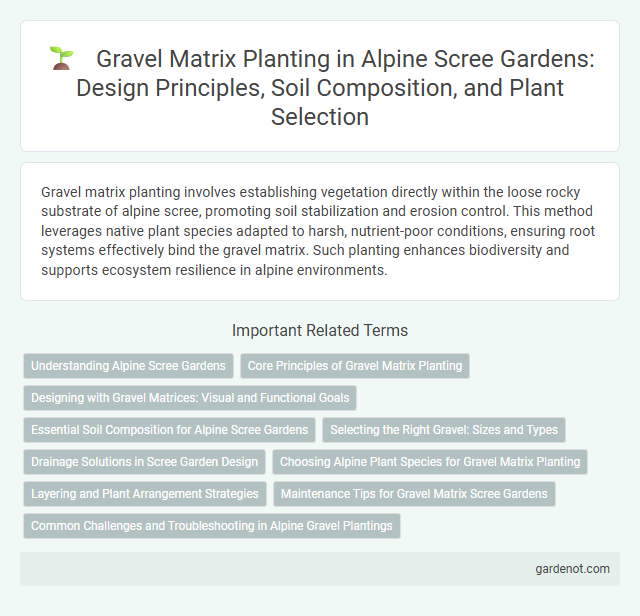Gravel matrix planting involves establishing vegetation directly within the loose rocky substrate of alpine scree, promoting soil stabilization and erosion control. This method leverages native plant species adapted to harsh, nutrient-poor conditions, ensuring root systems effectively bind the gravel matrix. Such planting enhances biodiversity and supports ecosystem resilience in alpine environments.
Understanding Alpine Scree Gardens
Gravel matrix planting in alpine scree gardens involves using well-draining, coarse gravel substrates to mimic natural scree environments, promoting healthy root development for specialized alpine plants. This technique ensures optimal water retention and aeration, preventing root rot and supporting drought-resistant species like Saxifraga and Sedum. Understanding the microhabitats within alpine scree ecosystems allows gardeners to select appropriate plants that thrive in nutrient-poor, rocky conditions.
Core Principles of Gravel Matrix Planting
Gravel matrix planting centers on stabilizing alpine scree habitats by using hardy, low-growing species that thrive in well-drained, nutrient-poor substrates. This method emphasizes selecting native plants with extensive root systems to anchor gravel and prevent erosion while facilitating water infiltration. Maintaining biodiversity and soil health through minimal disturbance ensures resilient plant communities adapted to extreme alpine conditions.
Designing with Gravel Matrices: Visual and Functional Goals
Designing with gravel matrices in alpine scree environments emphasizes creating a stable, well-drained substrate that supports drought-tolerant, low-maintenance plant species such as Sedum and Sempervivum. The visual goals focus on enhancing textural contrast and color variation to mimic natural scree slopes, while functional goals prioritize erosion control and root anchorage within the coarse gravel matrix. Incorporating plants with extensive fibrous root systems maximizes substrate binding and resilience against alpine weather extremes.
Essential Soil Composition for Alpine Scree Gardens
Alpine scree gardens require a gravel matrix with well-draining soil composed of coarse sand, small pebbles, and organic matter to mimic natural alpine conditions. The essential soil composition emphasizes low nutrient content and excellent drainage to prevent root rot and support hardy, drought-resistant plant species. Incorporating decomposed granite or grit enhances aeration and moisture retention, promoting optimal growth in gravel matrix planting.
Selecting the Right Gravel: Sizes and Types
Selecting the right gravel size and type is crucial for successful alpine scree gravel matrix planting, as it ensures proper drainage and root stability. Optimal gravel sizes range from 5 to 20 mm, allowing sufficient aeration while preventing soil compaction that can hinder alpine plant growth. Choosing angular, crushed gravel over rounded stones enhances interlocking and creates a stable matrix essential for plant establishment in alpine environments.
Drainage Solutions in Scree Garden Design
Gravel matrix planting enhances drainage solutions in scree garden design by allowing rapid water percolation and preventing soil erosion around alpine scree plants. The loose gravel substrate promotes oxygen flow to root systems, reducing the risk of root rot often caused by waterlogging in poorly drained soils. Integrating gravel with native drought-tolerant species ensures sustainable moisture management and mimics the natural alpine scree environment for optimal plant health.
Choosing Alpine Plant Species for Gravel Matrix Planting
Selecting alpine plant species for gravel matrix planting requires prioritizing drought-tolerant and low-maintenance varieties like Sedum, Saxifraga, and Draba, which thrive in well-drained, rocky substrates. These species exhibit strong root systems that stabilize gravel while withstanding temperature fluctuations and nutrient-poor conditions typical of alpine scree environments. Emphasizing native alpine plants enhances ecosystem compatibility and promotes biodiversity within gravel-based landscaping.
Layering and Plant Arrangement Strategies
Gravel matrix planting in alpine scree employs precise layering techniques that enhance drainage and root stability, crucial for harsh mountain conditions. Strategic plant arrangements prioritize drought-resistant species with varying root depths to optimize moisture retention and nutrient uptake across substrate layers. This method supports biodiversity by mimicking natural scree ecosystems and promoting plant resilience in nutrient-poor, well-drained gravel environments.
Maintenance Tips for Gravel Matrix Scree Gardens
Regularly monitor soil moisture in gravel matrix scree gardens to prevent waterlogging and root rot, ensuring plants adapted to alpine conditions thrive. Remove weeds promptly to reduce competition for nutrients and maintain the garden's aesthetic appeal. Periodic inspection of gravel stability and replenishment helps preserve the matrix's structure, promoting healthy plant anchorage and soil drainage.
Common Challenges and Troubleshooting in Alpine Gravel Plantings
Common challenges in alpine scree gravel matrix planting include poor drainage, soil erosion, and nutrient scarcity, which can hinder plant establishment and growth. Troubleshooting involves improving substrate composition with well-draining materials, implementing erosion control measures such as rock placement or geotextiles, and supplementing with appropriate fertilizers tailored to alpine plant nutritional needs. Monitoring moisture levels and selecting drought-resistant species are critical for maintaining healthy alpine gravel plantings under extreme environmental conditions.
Gravel matrix planting Infographic

 gardenot.com
gardenot.com